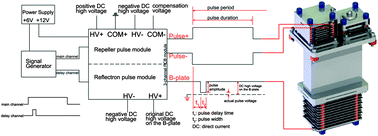A miniaturised electron ionisation time-of-flight mass spectrometer that uses a unique helium ion removal pulsing technique specifically for gas analysis
Abstract
A miniaturised

* Corresponding authors
a
Department of Chemistry, Fudan University, 220 Handan Road, Shanghai, China
E-mail:
pyyang@fudan.edu.cn
Fax: +86 21 65642009
Tel: +86 21 65642009
b Institute of Biomedical Science, Fudan University, 138 Yixueyuan Road, Shanghai, China
c
Institute of Atmospheric Environment Security and Pollution Control Engineering, Jinan University, Guangzhou, China
E-mail:
gwxmu@shu.edu.cn
Fax: +86 20 82071910
Tel: +86 21 82071902
d Guangzhou Hexin Anallytical Instrument CO LTD., Guangzhou, China
e Institute of Environment Pollution and Health, Shanghai University, Shanghai, China
A miniaturised

 Please wait while we load your content...
Something went wrong. Try again?
Please wait while we load your content...
Something went wrong. Try again?
J. Qing, Z. Huang, Y. Zhang, H. Zhu, G. Tan, W. Gao and P. Yang, Analyst, 2013, 138, 3394 DOI: 10.1039/C3AN00217A
To request permission to reproduce material from this article, please go to the Copyright Clearance Center request page.
If you are an author contributing to an RSC publication, you do not need to request permission provided correct acknowledgement is given.
If you are the author of this article, you do not need to request permission to reproduce figures and diagrams provided correct acknowledgement is given. If you want to reproduce the whole article in a third-party publication (excluding your thesis/dissertation for which permission is not required) please go to the Copyright Clearance Center request page.
Read more about how to correctly acknowledge RSC content.
 Fetching data from CrossRef.
Fetching data from CrossRef.
This may take some time to load.
Loading related content
